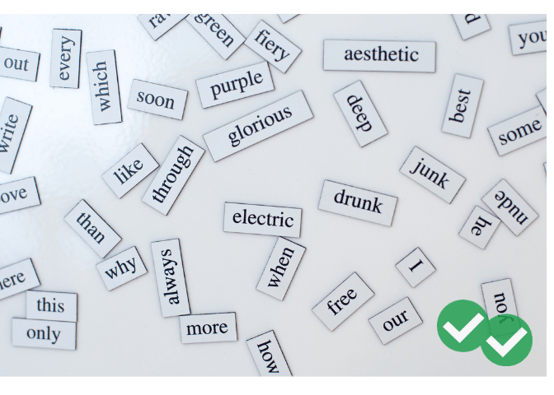
When I taught high school English, I was often asked by parents how I intended to help their students prepare for the ACT and SAT.
As teachers, there are many different ways to support high school test prep in your classroom, motivate your students for these tests, and specifically prepare them for testing in these uncertain times.
And if you’re an English teacher of any variety (literature, composition, creative writing, etc.) one of the best ways you can help prep your students for the ACT and SAT is to incorporate vocabulary practice into your curriculum. The good news is since you’re already teaching the English language, this can usually be done pretty organically!
A Brief Overview of ACT and SAT Vocabulary
The good news about the vocabulary components on these tests is that they’ve changed a lot over the years and no longer require rote memorization (which we as educators already know doesn’t lead to actual retention).
Here’s a super quick run-down of the way knowledge of vocabulary is addressed on each test.
 The SAT
The SAT
On the “new” SAT Test (2016 and beyond), there are 2 sections that deal with vocabulary: the Reading Test and the Writing and Language Test.
On both tests, there’s a “Words in Context” section that acts students to choose the most precise word to convey or improve meaning in a passage.
On the reading test specifically, students will also be asked to use context clues to determine the meaning of certain words or phrases, and then to reflect on how the author of a given passage shapes meaning through these linguistic choices.
And of course, beyond being explicitly tested on words and phrases, students will have an easier time comprehending fairly difficult reading passages (across multiple subjects) if their vocabulary is stronger.
The ACT
Vocabulary on the ACT is actually fairly similar to vocabulary on the SAT, at least in terms of difficulty and. Both tests claim to use “medium” difficulty words.
Additionally, the ACT English and ACT Reading tests both assess a student’s ability to understand words in context, as opposed to just memorizing them outright. Often, a word is underlined in a passage and a student must answer if there is a better word that could be used in context.
A key difference on the ACT is that there is also an ACT Science section, so it is helpful for students to have a decent knowledge of common scientific terms so that they can better understand the passages.
Vocabulary Practice
One way to help students improve their vocabulary for the ACT and SAT is to point them toward the wealth of vocabulary practice activities out there. You can even assign vocabulary practice, either for regular or extra credit, on top of whatever else you’re teaching in class.
Here is Magoosh’s SAT vocabulary archive, which includes SAT flashcards and the top 100 SAT words to know (including a downloadable PDF of words), among many other sources for studying SAT vocabulary.
Likewise, you can point your students to the ACT vocabulary archive, which also includes ACT flashcards and various vocabulary lists.
Literature Packed with ACT and SAT Vocabulary Words
Another amazing way to equip your students with loads of ACT and SAT vocabulary is to assign reading that’s chock full of great vocab!
We love this list of 100 classic books for college-bound readers and this overview of how to read like a college student, both of which provide examples of college-level texts that would serve as great ACT and SAT vocabulary prep.
Additionally, here’s a list of some primary sources (many that I’ve actually used in my own classroom!) that are packed with vocabulary on par with what students will find on the SAT and ACT.
Obviously depending on what else you’re teaching, these texts may or may not fit into your curriculum, but if you want texts that are full of SAT and ACT vocabulary, these are some great examples.
 Test of Time : A Novel Approach to the SAT and ACT
Test of Time : A Novel Approach to the SAT and ACT
Test of Time: A Novel Approach to the SAT and ACT, by Charles Harrington Elster, is a time-traveling narrative that’s deliberately stuffed with common SAT and ACT vocabulary words, all of which are highlighted. It also includes a glossary within the text so that students can easily look words up.
Similarly, Elster also wrote a mystery novel called Tooth and Nail: A Novel Approach to the SAT with Joseph-Elliot.
If you’re having hard time fitting either of these genres into your curriculum, you can incentivize your students to read them by offering extra credit for doing so.
Busted: An SAT Vocabulary Novel
Busted: An SAT Vocabulary Novel by Emma Harrison is one of a series of “smart novels” intended to introduce students to a wealth of SAT terms through plotlines and themes that appeal to teens. Definitions of words appear right on the same page, so students don’t have to flip back and forth and break focus.
Smart novels can also be a bit tricky to incorporate into your regular curriculum but again, you can offer extra credit to students who read them or work them into your other literary units as works best for you.
The Scarlet Letter
Nathaniel Hawthorne’s American Romantic classic The Scarlet Letter is absolutely packed with SAT and ACT vocabulary, which is a huge part of why I taught it for years. If you don’t have time to teach this long and dense novel, short stories by Nathaniel Hawthorne are also typically full of advanced vocabulary. For example, you could teach “The Artist of the Beautiful,” “Young Goodman Brown,” or “The Birthmark,” all of which are full of great vocabulary.
Other authors from this literary canon and time period include Edgar Allen Poe, Stephen Crane, and Herman Melville--all of which used notoriously verbose vocabulary that is perfect for ACT and SAT prep.
Wuthering Heights
Wuthering Heights, Charlotte Bronte’s highly dramatic and passionately romantic novel is a teacher favorite for test prep vocabulary, especially for freshmen and sophomores.
Heart of Darkness
A notoriously challenging text, Joseph Conrad’s Heart of Darkness (a first personal narrative about a journey up the Congo River) is full of ACT and SAT vocabulary, and includes a good deal of geopolitical language that may be helpful for students with test taking. The density of this text is also ideal for ACT and SAT reading practice.
Ceremony
Leslie Marmon Silko’s Ceremony, an exquisite novel about a Native American WWII veteran returning to a reservation is a challenging read. Because it uses a web-style, non-linear narrative, it helps students navigate more structurally complex passages and introduces them to a broad range of sociocultural terms outside the typical anglocentric literary canon.
Frankenstein
Mary Shelley's Frankenstein is a parable the risks of unrestrained science and progress and therefore contains a good deal of vocabulary pertaining to science that are particularly helpful on the ACT.
The Awakening
Kate Chopin's The Awakening, a text commonly included on AP Lit and Women's Lit reading lists, is rich with test-caliber vocabulary words, and it's a novella that is easy to fit into curriculum.
Beloved
Every novel by contemporary master of American Literature Toni Morrison is brimming with vibrant, complex language that is helpful for students in preparing for the ACT and SAT, and Beloved is no exception.
Tips for Teaching ACT and SAT Vocabulary
Discuss Words in Context
As we all know, memorizing vocabulary isn’t at all effective for long-term retention and understanding. When I assigned nightly reading to my students, I asked them to look up a minimum of 5 new words (even if they thought they knew the definition), write down the definition(s), and use each in a sentence. This became such a standard part of my curriculum because I found that it became second nature for students to look up words and then use them correctly. Whenever possible, have students share some of the new words they learned during your group discussion of the reading.
Stress Multiple Meanings and Synonyms
Whenever possible, when discussing new vocabulary that your students have come upon in their reading, make sure to discuss both secondary definitions and common synonyms for the word. The ACT and SAT are known for using words in context with their lesser-known meanings, so this is a super helpful approach.
Teach Idioms
The ACT is known for using plenty of idioms and then asking questions about their meanings, so try to teach a mini-lesson on these types of common phrases if possible. Students have often heard them, but discussing their uses and connotations is valuable.
Work in Science Vocabulary
The ACT includes science passages so it can't hurt to include science-related vocabulary.
Encourage Audio Books and E-Readers
I typically maintain that listening to literature isn't a full replacement for reading it, but for many students, following along with an audio reading allows them to visually take in the text in a more meaningful way. With E-readers (like Kindle, Nook, etc.), there is often a feature that allows students to highlight and look up words easily as they're reading their digital text.
Encourage Students to Annotate
Encourage your students to annotate their texts, including circling words they don't know and looking them up, either during or after reading. Annotating will help them stay more engaged with the language and will create the habit of looking up unfamiliar words.
Assign Regular Non-Fiction Readings
Publications like Time, The New Yorker, The Atlantic Monthly, and Harpers are all packed with SAT and ACT vocabulary. Consider assigning a weekly non-fiction article (news or editorial) related to the content you're teaching to help your students broaden their vocabulary. This is especially helpful since not all of the passages used on the ACT and SAT are fiction.
Teach Critical Thinking Verbs
Make sure your students are familiar with and know the difference between words related to critical thinking directives. For example, stress the difference between being asked to "analyze" versus "explain." This is an excellent taxonomy of critical thinking verbs you can share with your students.
Good Luck and Happy Teaching!
Teaching vocabulary isn't every teacher's favorite item on the agenda, but whenever you can work vocabulary into your curriculum the better. Even if the words you discuss with your students aren't on the actual SAT or ACT, the process of investigating and using new words is super helpful to their test prep process.


